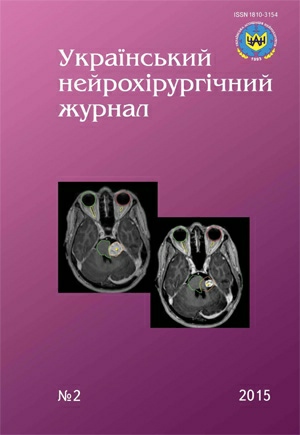Endoscopic decompression of middle nerve in patients with carpal tunnel syndrome
DOI:
https://doi.org/10.25305/unj.45296Keywords:
carpal tunnel syndrome, median nerve, endoscopic decompressionAbstract
Purpose. Results of endoscopic surgical treatment evaluation in patients with carpal tunnel syndrome.
Materials and methods. For median nerve decompression in the carpal tunnel endoscopic technique and K.G. Krishnan tools were selected. The detailed technique of endoscopic intervention using carpal approach is described. The results of 34 patient’s treatment with carpal tunnel syndrome (CTS) were analyzed.
Results. Patients’ state was evaluated before surgery, on the 7 and 30 days after surgery. Regression of neuropathic pain, according to the questionnaire BCTQ, was observed in all operated patients. Functional outcome worsened on the 7day after surgery, but in a month later patients reported significant improvement in hand function that corresponds to changes in control electroneuromyography and ultrasound scanning of the middle nerve. In one case after surgery hypoesthesia regression was not achieved.
Conclusions. Endoscopic technique is a method of choice in patients with CTS. Due to miniinvasive approach and sufficient carpal tunnel visualization, it can be successfully used in routine neurosurgical practice. Treatment results indicate efficacy of endoscopic method and fast rehabilitation of the patients.
References
Chow J. Endoscopic release of the carpal ligament: A new technique for carpal tunnel syndrome. Arthroscopy: The Journal of Arthroscopic & Related Surgery. 1989;5(1):19-24. CrossRef
Meirelles L, Santos J, Santos L, Branco M, Faloppa F, Leite V, Fernandes C. Avaliação do questionário de Boston aplicado no pós-operatório tardio da síndrome do tunel do carpo operados pela técnica de retinaculótomo de paine por via palmar. Acta Ortopédica Brasileira. 2006;14(3). CrossRef
Martin KD, Dützmann S, Sobottka SB, Rambow S, Mellerowicz HA, Pinzer T, Schackert G, Krishnan KG. Retractor-Endoscopic Nerve Decompression in Carpal and Cubital Tunnel Syndromes: Outcomes in a Small Series. World Neurosurgery. 2014;82(1-2):e361-e370. CrossRef
Iannotti J, Parker R. Musculoskeletal System. Part II. Spine And Lower Limb. In: Netter F, ed. The Ciba Collection Of Medical Illustrations. New Jersey: CIBA-Geigy; 1987.
Cobb T, Dalley B, Posteraro R, Lewis R. Anatomy of the flexor retinaculum. The Journal of Hand Surgery. 1993;18(1):91-99. CrossRef
Mirza M, King E Jr. Newer techniques of carpal tunnel release. Orthop Clin North Am. 1996; 27(2):355–371. PubMed
Kretschmer T, Antoniadis G, Richter H, König R. Avoiding Iatrogenic Nerve Injury in Endoscopic Carpal Tunnel Release. Neurosurgery Clinics of North America. 2009;20(1):65-71. CrossRef
Agee J, McCarroll H, Tortosa R, Berry D, Szabo R, Peimer C. Endoscopic release of the carpal tunnel: A randomized prospective multicenter study. The Journal of Hand Surgery. 1992;17(6):987-995. CrossRef
Downloads
Published
How to Cite
Issue
Section
License
Copyright (c) 2015 Vitaliy Tsymbaliuk, Iurii Chyrka

This work is licensed under a Creative Commons Attribution 4.0 International License.
Ukrainian Neurosurgical Journal abides by the CREATIVE COMMONS copyright rights and permissions for open access journals.
Authors, who are published in this Journal, agree to the following conditions:
1. The authors reserve the right to authorship of the work and pass the first publication right of this work to the Journal under the terms of Creative Commons Attribution License, which allows others to freely distribute the published research with the obligatory reference to the authors of the original work and the first publication of the work in this Journal.
2. The authors have the right to conclude separate supplement agreements that relate to non-exclusive work distribution in the form of which it has been published by the Journal (for example, to upload the work to the online storage of the Journal or publish it as part of a monograph), provided that the reference to the first publication of the work in this Journal is included.









